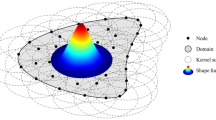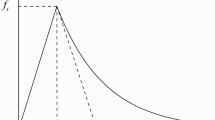Abstract
In this paper, a displacement–pressure (u–p) semi-Lagrangian reproducing kernel (RK) is introduced to study the penetration depth of various projectile types into dry and fully saturated geo-materials. To describe the poromechanics of saturated materials, Biot theory is incorporated into the semi-Lagrangian formulation and a damage model is embedded into Drucker–Prager constitutive model to simulate the soil behavior and separation during the impact and penetration process. The stabilized nodal domain integration is developed in the two-field semi-Lagrangian RK formulation to ensure numerical stability, and the kernel contact algorithm is implemented to model the interaction between soil and projectile bodies. Several examples are studied to validate and assess the proposed method’s performance in predicting the final penetration depth, and the results are compared to those reported in the literature.














Similar content being viewed by others
References
Backman ME, Goldsmith W (1978) The mechanics of penetration of projectiles into targets. Int J Eng Sci 16(1):1–99
Byers RK, Yarrington P, Chabai AJ (1978) Dynamic penetration of soil media by slender projectiles. Int J Eng Sci 16:835–844
Borg JP et al (2013) In situ velocity and stress characterization of a projectile penetrating a sand target: experimental measurements and continuum simulations. Int J Impact Eng 51:23–35
Omidvar M, Iskander M, Bless S (2014) Response of granular media to rapid penetration. Int J Impact Eng 66:60–82
Forrestal MJ, Luk VK (1992) Penetration into soil targets. Int J Impact Eng 12(3):427–444
Savvateev AF et al (2001) High-speed penetration into sand. Int J Impact Eng 26(1):675–681
Bless SJ et al (2009) Sand penetration by high speed projectiles. AIP Conference Proc 1195(1):1361–1364
Seguin A et al (2009) Sphere penetration by impact in a granular medium: a collisional process. EPL (Europhys Lett) 88(4):44002
Orphal DL (2006) Explosions and impacts. Int J Impact Eng 33(1):496–545
Xu J et al (2014) A study on the ricochet of concrete debris on sand. Int J Impact Eng 65:56–68
Guzman IL, Iskander M, Bless S (2015) Observations of projectile penetration into a transparent soil. Mech Res Commun 70:4–11
Finno R (1994) Analytical interpretation of dilatometer penetration through saturated cohesive soils. Geotechnique 43(2):241–254
Teh CI, Houlsby GT (1991) An analytical study of the cone penetration test in clay. Geotechnique 41(1):17–34
Boguslavskii Y, Drabkin S, Salman A (1996) Analysis of vertical projectile penetration in granular soils. J Phys D Appl Phys 29(3):905–916
Yankelevsky DZ, Gluck J (1980) Nose shape effect on high velocity soil penetration. Int J Mech Sci 22(5):297–311
Rubin MB (2012) Analytical formulas for penetration of a long rigid projectile including the effect of cavitation. Int J Impact Eng 40–41:1–9
van den Peter B, Borst R, Huetink H (1996) An Eulerian finite element model for penetration in layered soil. Int J Numer Anal Meth Geomech 20:865–886
Walker J, Yu HS (2006) Adaptive finite element analysis of cone penetration in clay. Acta Geotechnica 1:43–57
Wang D et al (2015) Large deformation finite element analyses in geotechnical engineering. Comput Geotech 65:104–114
Huang W et al (2004) Finite element analysis of cone penetration in cohesionless soil. Comput Geotech 31(7):517–528
Børvik T et al (2002) Perforation of 12 mm thick steel plates by 20 mm diameter projectiles with flat, hemispherical and conical noses: Part I: experimental study. Int J Impact Eng 27(1):19–35
Arias A, Rodríguez-Martínez JA, Rusinek A (2008) Numerical simulations of impact behaviour of thin steel plates subjected to cylindrical, conical and hemispherical non-deformable projectiles. Eng Fract Mech 75(6):1635–1656
Scheffler DR (2005) Modeling non-eroding perforation of an oblique aluminum target using the Eulerian CTH hydrocode. Int J Impact Eng 32(1):461–472
Jiang MJ, Yu H-S, Harris D (2006) Discrete element modelling of deep penetration in granular soils. Int J Numer Anal Meth Geomech 30(4):335–361
Balevičius R, Džiugys A, Kačianauskas R (2004) Discrete element method and its application to the analysis of penetration into granular media. J Civ Eng Manag 10(1):3–14
Børvik T, Dey S, Olovsson L (2015) Penetration of granular materials by small-arms bullets. Int J Impact Eng 75:123–139
Tran QA, Chevalier B, Breul P (2016) Discrete modeling of penetration tests in constant velocity and impact conditions. Comput Geotech 71:12–18
Pica Ciamarra M et al (2004) Dynamics of drag and force distributions for projectile impact in a granular medium. Phys Rev Lett 92(19):194301
Li S, Liu WK (2004) Meshfree particle methods. Springer, Berlin
Johnson GR, Cook WH (1993) Lagrangian EPIC code computations for oblique, yawed-rod impacts onto thin-plate and spaced-plate targets at various velocities. Int J Impact Eng 14(1):373–383
Moxnes JF et al (2016) On the study of ricochet and penetration in sand, water and gelatin by spheres, 7.62 mm APM2, and 25 mm projectiles. Def Technol 12(2):159–170
Holmen JK, Olovsson L, Børvik T (2017) Discrete modeling of low-velocity penetration in sand. Comput Geotech 86:21–32
Johnson GR, Stryk RA, Beissel SR (1996) SPH for high velocity impact computations. Comput Methods Appl Mech Eng 139(1):347–373
Johnson GR (1994) Linking of Lagrangian particle methods to standard finite element methods for high velocity impact computations. Nucl Eng Des 150(2):265–274
Bui HH et al (2008) Lagrangian meshfree particles method (SPH) for large deformation and failure flows of geomaterial using elastic–plastic soil constitutive model. Int J Numer Anal Meth Geomech 32(12):1537–1570
Norouz Oliaei M, Soga K, Pak A (2009) Some numerical issues using element-free Galerkin mesh-less method for coupled hydro-mechanical problems. Int J Numer Anal Meth Geomech 33:915–938
Wang D et al (2019) A three-dimensional two-level gradient smoothing meshfree method for rainfall induced landslide simulations. Front Struct Civ Eng 13(2):337–352
Shibata T, Murakami A (2011) A stabilization procedure for soil-water coupled problems using the element-free Galerkin method. Comput Geotech 38(5):585–597
Wei H, Chen J-S, Hillman M (2016) A stabilized nodally integrated meshfree formulation for fully coupled hydro-mechanical analysis of fluid-saturated porous media. Comput Fluids 141:105–115
Xie Y, Wang G (2014) A stabilized iterative scheme for coupled hydro-mechanical systems using reproducing kernel particle method. Int J Numer Meth Eng 99(11):819–843
Liu WK, Jun S, Zhang YF (1995) Reproducing kernel particle methods. Int J Numer Meth Fluids 20(8–9):1081–1106
Chen J-S et al (1996) Reproducing kernel particle methods for large deformation analysis of non-linear structures. Comput Methods Appl Mech Eng 139(1):195–227
Chi S-W et al (2015) A level set enhanced natural kernel contact algorithm for impact and penetration modeling. Int J Numer Meth Eng 102(3–4):839–866
Siriaksorn T et al (2018) u–p semi-Lagrangian reproducing kernel formulation for landslide modeling. Int J Numer Meth Eng Geomech 42(2):231–255
Chen J-S, Hillman M, Chi S-W (2017) Meshfree methods: progress made after 20 years. J Eng Mech 143(4):04017001
Guan PC et al (2011) Semi-Lagrangian reproducing kernel particle method for fragment-impact problems. Int J Impact Eng 38(12):1033–1047
Sherburn JA et al (2015) Meshfree modeling of concrete slab perforation using a reproducing kernel particle impact and penetration formulation. Int J Impact Eng 86:96–110
Bessa MA et al (2014) A meshfree unification: reproducing kernel peridynamics. Comput Mech 53(6):1251–1264
Silling SA (2000) Reformulation of elasticity theory for discontinuities and long-range forces. J Mech Phys Solids 48(1):175–209
Silling SA, Lehoucq RB (2008) Convergence of peridynamics to classical elasticity theory. J Elast 93(1):13–37
Wu CT et al (2017) Three-dimensional concrete impact and penetration simulations using the smoothed particle Galerkin method. Int J Impact Eng 106:1–17
Wu Y, Wu CT (2018) Simulation of impact penetration and perforation of metal targets using the smoothed particle Galerkin method. J Eng Mech 144(8):04018057
Dolbow J, Belytschko T (1999) Numerical integration of the Galerkin weak form in meshfree methods. Comput Mech 23(3):219–230
Chen J-S et al (2001) A stabilized conforming nodal integration for Galerkin mesh-free methods. Int J Numer Meth Eng 50(2):435–466
Chen J-S, Yoon S, Wu C-T (2002) Non-linear version of stabilized conforming nodal integration for Galerkin mesh-free methods. Int J Numer Meth Eng 53(12):587–2615
Chen J-S, Hillman M, Rüter M (2013) An arbitrary order variationally consistent integration for Galerkin meshfree methods. Int J Numer Meth Eng 95(5):387–418
Hillman M, Chen J-S, Chi S-W (2014) Stabilized and variationally consistent nodal integration for meshfree modeling of impact problems. Comput Part Mech 1(3):245–256
Chen JS et al (2007) Strain smoothing for stabilization and regularization of Galerkin meshfree methods. In: Griebel M, Schweitzer MA (eds) Meshfree methods for partial differential equations III. Springer, Berlin, pp 57–75
Wu C-T et al (2016) Strain gradient stabilization with dual stress points for the meshfree nodal integration method in inelastic analyses. Int J Numer Meth Eng 107(1):3–30
Hillman M, Chen J-S (2016) An accelerated, convergent, and stable nodal integration in Galerkin meshfree methods for linear and nonlinear mechanics. Int J Numer Meth Eng 107(7):603–630
Wu CT et al (2018) Numerical and experimental validation of a particle Galerkin method for metal grinding simulation. Comput Mech 61(3):365–383
Chen J-S, Wu Y (2007) Stability in Lagrangian and semi-Lagrangian reproducing kernel discretizations using nodal integration in nonlinear solid mechanics. Springer, Dordrecht
Biot MA (1963) Theory of stability and consolidation of a porous medium under initial stress. J Math Mech 12(4):521–541
Chi S-W, Siriaksorn T, Lin S-P (2016) Von Neumann stability analysis of the u–p reproducing kernel formulation for saturated porous media. Comput Mech 59(2):335–357
Puso MA et al (2008) Meshfree and finite element nodal integration methods. Int J Numer Meth Eng 74(3):416–446
Simo JC, Ju JW (1987) Strain- and stress-based continuum damage models—I. Formulation. Int J Solids Struct 23(7):821–840
Castellanos A et al (2009) Cohesion and internal friction of fine glass beads as affected by small intensity vertical vibration. AIP Conference Proc 1145(1):707–710
Khan M (2015) Mechanics of projectile penetration into non-cohesive soil targets. Int J Civil Eng 13:28–39
Acknowledgements
The support from the U.S. Strategic Environmental Research and Development Program (SERDP) under contract number W912HQ18C0099 is gratefully acknowledged.
Author information
Authors and Affiliations
Corresponding author
Ethics declarations
Conflict of interest
On behalf of all authors, the corresponding author states that there is no conflict of interest.
Additional information
Publisher's Note
Springer Nature remains neutral with regard to jurisdictional claims in published maps and institutional affiliations.
Rights and permissions
About this article
Cite this article
Mahdavi, A., Chi, SW. & Atif, M.M. A two-field semi-Lagrangian reproducing kernel model for impact and penetration simulation into geo-materials. Comp. Part. Mech. 7, 351–364 (2020). https://doi.org/10.1007/s40571-019-00253-0
Received:
Revised:
Accepted:
Published:
Issue Date:
DOI: https://doi.org/10.1007/s40571-019-00253-0




